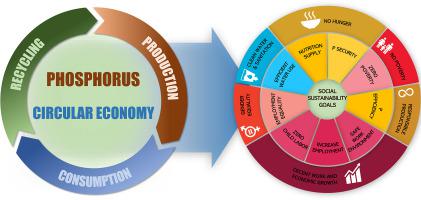Science of the Total Environment ( IF 8.2 ) Pub Date : 2021-02-25 , DOI: 10.1016/j.scitotenv.2021.146060 Mohammad El Wali , Saeed Rahimpour Golroudbary , Andrzej Kraslawski

|
To be able to grow crops, we have interfered with Earth's reserves of one of top three essential elements, phosphorus (P), as to which we face a problem related to its high consumption compared to available resources. This forces us to follow the alternative of closing the phosphorus loop from a circular economy perspective. However, there is a lack of research on regional and global social sustainability in this area, as emphasized in the United Nations' Agenda 2030 goals for sustainable development. In this paper, we address social challenges involved in global phosphorus supply chain, such as eradicating poverty, child labor and malnutrition; promoting gender equality; providing decent work and economic growth; maintaining sustainable water use; and achieving food security. Our research is driven by the question of whether the circular economy aims to direct phosphorus management towards tackling social issues associated with its supply chain. We use system dynamics modelling by combining the concept of material flow analysis and social life cycle assessment. Detailed analysis at regional and global levels indicates a paradoxical social impact of phosphorus circular model. This reflects the multiple stakeholders involved, and the regional interactions with phosphorus circular economy transitions. Improvements can be demonstrated in reducing poverty and providing safer work environment in many regions, e.g., Western Asia (93%), New Zealand, Central Asia, and Europe (44–61%), while achieving employment targets is limited in Northern and Eastern Europe. Circular model fails to promote gender equality, it also exacerbates exploitative child work problem for the Caribbean and most Africa. It provides sufficient nutrition to North America, Australia/New Zealand, and Northern Europe. It achieves water use targets in several regions with 53% savings worldwide. Finally, circular model contributes to P efficiency (average balance of 1.21 kgP/ha) and strengthens P security within most regions with an average of 64%.
中文翻译:

磷供应链的循环经济及其对社会可持续发展目标的影响
为了能够种植农作物,我们干扰了地球上三大基本元素之一的储量,磷(P),与可利用的资源相比,我们面临着与高消耗有关的问题。从循环经济的角度来看,这迫使我们采取封闭磷循环的替代方案。但是,正如联合国《 2030年议程》中的可持续发展目标所强调的那样,在这一领域缺乏关于区域和全球社会可持续性的研究。在本文中,我们解决了全球磷供应链中涉及的社会挑战,例如消除贫困,童工和营养不良;促进性别平等;提供体面的工作和经济增长;维持可持续用水;并实现粮食安全。我们的研究受到循环经济是否旨在引导磷管理以解决与其供应链相关的社会问题的问题的驱动。我们通过结合物质流分析和社会生命周期评估的概念来使用系统动力学建模。在区域和全球范围内进行的详细分析表明,磷循环模型对社会产生了反常的影响。这反映了所涉及的多个利益相关者,以及磷循环经济转型带来的区域互动。在许多地区,例如西亚(93%),新西兰,中亚和欧洲(44-61%),在减少贫困和提供更安全的工作环境方面可以证明有所改善,而在北部和东部,实现就业目标是有限的欧洲。循环模式未能促进性别平等,这也加剧了加勒比地区和大多数非洲的剥削性童工问题。它为北美,澳大利亚/新西兰和北欧提供足够的营养。它实现了多个地区的用水目标,全球范围内节省了53%。最后,循环模式有助于提高磷效率(平均平衡为1.21 kgP / ha),并以64%的平均值提高大多数地区的磷安全性。









































 京公网安备 11010802027423号
京公网安备 11010802027423号